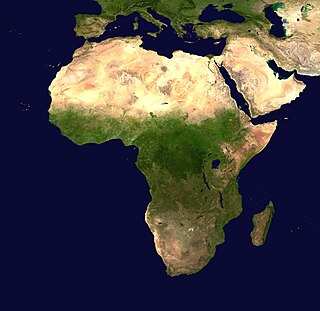
The natural history of Africa encompasses some of the well known megafauna of that continent.

Scorpions are predatory arachnids of the order Scorpiones. They have eight legs, and are easily recognized by a pair of grasping pincers and a narrow, segmented tail, often carried in a characteristic forward curve over the back and always ending with a stinger. The evolutionary history of scorpions goes back 435 million years. They mainly live in deserts but have adapted to a wide range of environmental conditions, and can be found on all continents except Antarctica. There are over 2,500 described species, with 22 extant (living) families recognized to date. Their taxonomy is being revised to account for 21st-century genomic studies.

The Union of South Africa is the historical predecessor to the present-day Republic of South Africa. It came into being on 31 May 1910 with the unification of the Cape Colony, the Natal Colony, the Transvaal, and the Orange River Colony. It included the territories that were formerly a part of the South African Republic and the Orange Free State.

The Orange River is a river in Southern Africa. It is the longest river within the borders of South Africa and the Orange River Basin extends extensively from Lesotho into South Africa and Namibia to the north. It rises in the Drakensberg mountains in Lesotho, flowing westwards through South Africa to the Atlantic Ocean. The river forms part of the international borders between South Africa and Lesotho and between South Africa and Namibia, as well as several provincial borders within South Africa. Except for Upington, it does not pass through any major cities. The Orange River plays an important role in the South African economy by providing water for irrigation and hydroelectric power. The river was named the Orange River in honour of the Dutch ruling family, the House of Orange, by the Dutch explorer Robert Jacob Gordon. Other names include simply the word for river, in Khoekhoegowab orthography written as !Garib, which is rendered in Afrikaans as Gariep River with the intrusion of a velar fricative in place of the alveolar click, Groote River or Senqu River, derived from ǂNū "Black".

The rockjumpers are medium-sized insectivorous or omnivorous birds in the genus Chaetops, which constitutes the entire family Chaetopidae. The two species, the Cape rockjumper, Chaetops frenatus, and the Drakensberg rockjumper, Chaetops aurantius, are endemic residents of southern Africa. The Cape rockjumper is a resident of the West Cape and south-west East Cape, and the orange-breasted rockjumper is distributed in the Lesotho Highlands and areas surrounding them in South Africa. The two rockjumpers have been treated as separate species but differ in size and plumage. The ranges do not overlap, but come close to doing so.

Solifugae is an order of animals in the class Arachnida known variously as camel spiders, wind scorpions, sun spiders, or solifuges. The order includes more than 1,000 described species in about 153 genera. Despite the common names, they are neither true scorpions nor true spiders. Most species of Solifugae live in dry climates and feed opportunistically on ground-dwelling arthropods and other small animals. The largest species grow to a length of 12–15 cm (5–6 in), including legs. A number of urban legends exaggerate the size and speed of the Solifugae, and their potential danger to humans, which is negligible.

The Cheetahs, is a South African professional rugby union team that played Super Rugby between 2006 and 2017, before joining the Pro14 competition prior to the 2017–18 season. They are based at the Free State Stadium in Bloemfontein.

Parabuthus transvaalicus is a species of venomous scorpion from semi-arid parts of southern Africa.
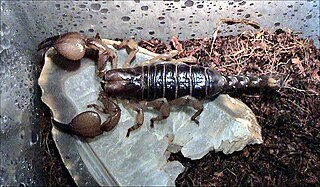
Opistophthalmus is a genus of scorpions known commonly as burrowing scorpions, tricolored scorpions, serkets, or hissing scorpions. They are found predominantly in southern Africa. They are known for making deep and elaborate burrows.

The Angolan slender mongoose is a mongoose native to southwestern Africa, specifically southwestern Angola and northwestern Namibia. It has been listed as "Least Concern" on the IUCN Red List, as it is not threatened and thought to be common. It has a long, slim body and there are different colour forms, a black or dark brown form in the southern part of its range, and a yellowish- or reddish-brown form in the north. This mongoose inhabits dry, rocky habitats and feeds on insects, scorpions and small vertebrates.
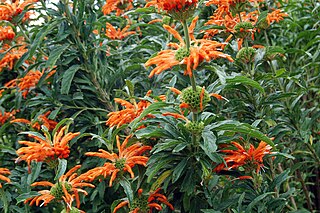
Leonotis leonurus, also known as lion's tail and wild dagga, is a plant species in the mint family, Lamiaceae. The plant is a broadleaf evergreen large shrub native to South Africa and southern Africa, where it is very common. It is known for its medicinal properties. The main psychoactive component of Leonotis leonurus is claimed to be leonurine, even though leonurine has never been found in the plant using chemical analysis. Like other plants in the mint family, it also contains marrubiin. The name 'wild dagga' links it closely to cannabis as 'dagga' derived from the Khoikhoi 'dachab' is an indigenous South African name for cannabis species. This name may be a misnomer, as no part of the plant is used as a hallucinogen.
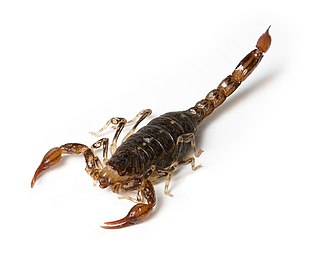
Cercophonius squama, commonly known as the forest scorpion or wood scorpion, is a scorpion native to southeastern Australia. It is typically around 25–40 mm (0.98–1.57 in) long. Its colour consists of different shades of brown.

Hadogenes troglodytes is a species of scorpion from southern Africa. It is commonly known as the flat rock scorpion and commonly sold on the exotic pet market. It was once regarded as having the longest recorded body length of any scorpion, reaching up to 20 cm, however Heterometrus swammerdami currently holds the record for being the world's largest scorpion at 9 inches (23 cm) in length.
Birtoxin is a neurotoxin from the venom of the South African Spitting scorpion. By changing sodium channel activation, the toxin promotes spontaneous and repetitive firing much like pyrethroid insecticides do

Nucras tessellata, the western or striped sandveld lizard, tiger lizard, or striped or banded sand lizard, is native to the west coast of Southern Africa. It is found in the Western Cape, Tankwa Karoo National Park, Richtersveld, Botswana, Kalahari Gemsbok National Park and Namibia. Although preferring arid, sandy areas they also stray into fynbos and mountain grassland. Members of the genus Nucras have a cylindrical body and an extremely long tail. They are secretive and not often seen.

The black hairy thick-tailed scorpion, Parabuthus villosus, is a species of scorpion from southern Africa, where it ranges from the Northern Cape to Namibia. It is the largest species of the Buthidae, measuring up to 18 cm, and its diet may include lizards and mice. The species is often active at dawn and dusk, but takes refuge by day in a variety of shelters. It resembles Parabuthus transvaalicus, which is more strictly nocturnal, less hairy and with a more easterly distribution.

Parabuthus is a genus of large and highly venomous Afrotropical scorpions, that show a preference for areas of low rainfall. Their stings are medically important and human fatalities have been recorded.
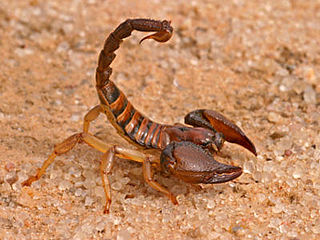
The robust burrowing scorpion is a widespread species of scorpion in the drier regions of southern Africa. It is a burrowing scorpion, which often places its burrow beside a large rock. Compared to others of its genus, it has a particularly sturdy body with large pinchers.
Parabuthus brevimanus is a species of scorpion from southern Africa, that ranges from southern Angola to Namibia and western South Africa, where its range extends south of the Orange River.

Hadogenes is a genus of large African scorpions found from South Africa up to Tanzania.
















